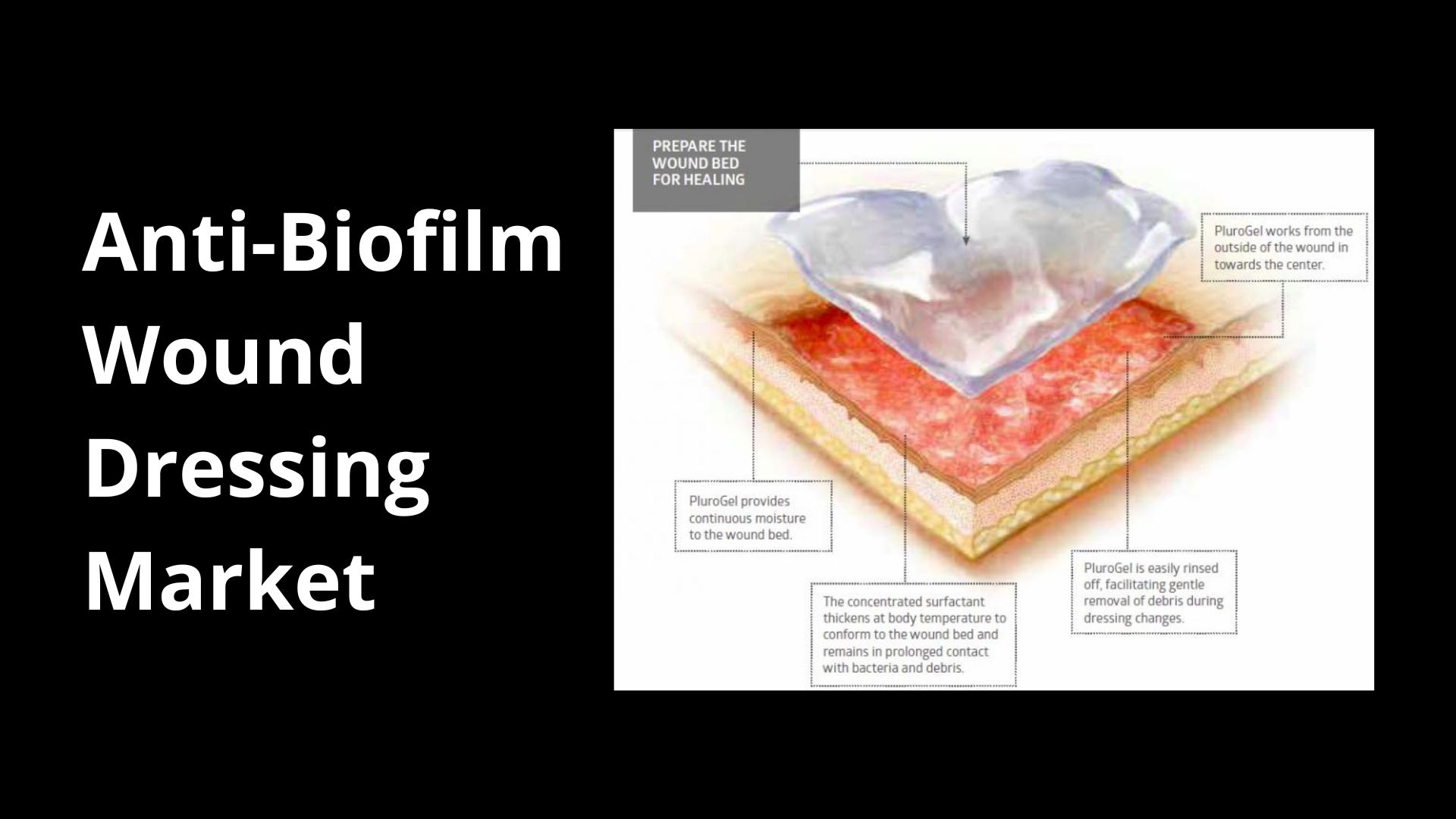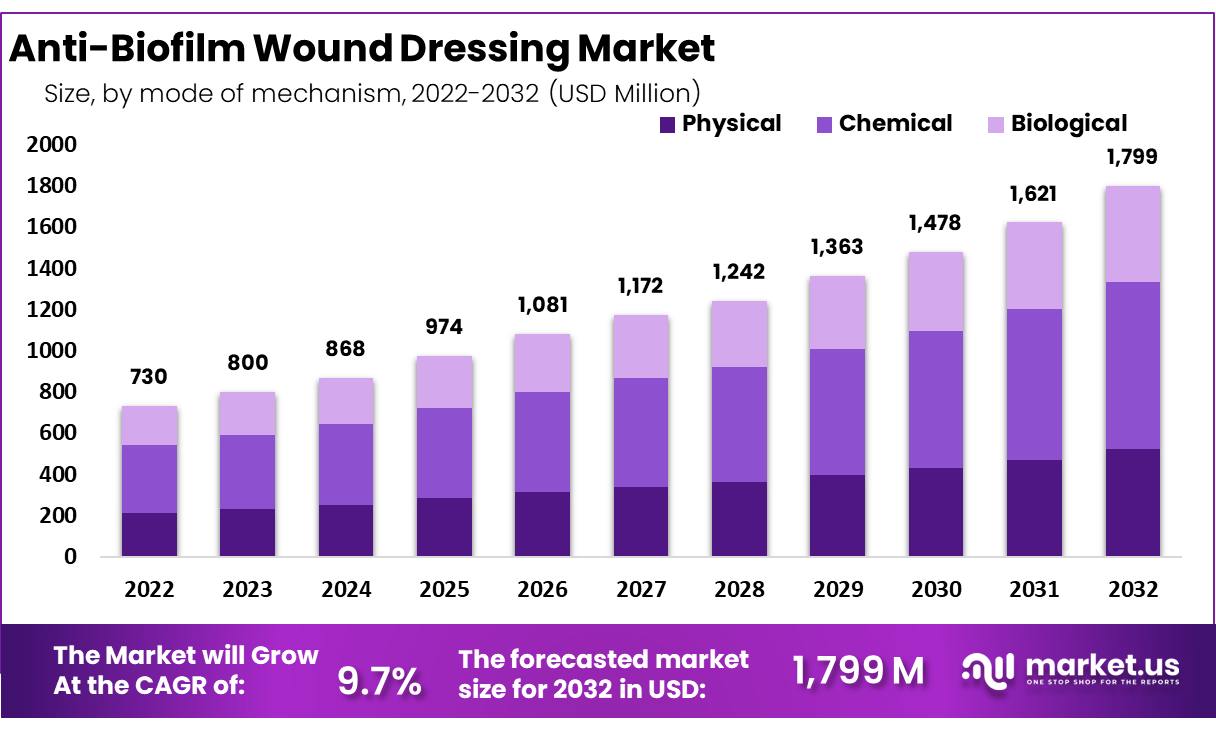Anti-Biofilm Wound Dressing Market Sales to Top USD 1,799 Million in 2032 at a CAGR of close to 9.7%, says Market.us

Page Contents
Market Overview
Published Via 11Press : An anti-biofilm wound dressing is a medical device designed to prevent and eliminate bacterial biofilms on the surface of a wound. Biofilms are communities of bacteria that form a protective layer around themselves, making them difficult to treat with traditional antibiotics. These biofilms can cause chronic infections, delayed healing, and even lead to sepsis.
In 2022, the global anti-biofilm wound dressing market accounted for USD 730 Million and is expected to grow to around USD 1,799 Million in 2032. Between 2023 and 2032, this market is estimated to register the highest CAGR of 9.7%.
Anti-biofilm wound dressings incorporate various technologies that disrupt the formation and growth of biofilms. Some examples include silver ions, enzymes, or antimicrobial peptides. These dressings not only prevent colonization by bacteria but also promote healing by providing a moist environment for the wound.
The global market for anti-biofilm wound dressings is rapidly expanding due to increasing awareness about the importance of preventing biofilm-associated infections in healthcare settings. With advancements in research and development, there is potential for more effective and innovative anti-biofilm technologies to emerge in this market.

Request For Sample Report Here: https://market.us/report/anti-biofilm-wound-dressing-market/request-sample/
Key Takeaway
- North America is projected to experience a CAGR of 9.9% between 2023-2032 and the highest share in terms of revenue generated.
- The United Kingdom's population growth projection for 2023-2032 stands at 9.1% annually.
- Asia Pacific is projected to experience rapid development between 2023-2032.
- Through their operation of the mechanism, chemicals accounted for over 40% of revenue generation by 2022.
- Through its mechanism of action, this sector should experience rapid compound annualized growth between 2023-2032.
- Chronic wound care was responsible for more than 60% of revenue generated in 2022.
- Forecasted growth projections show acute wound types increasing at an astounding compound annual growth rate between 2023-2032.
- Hospital end-users were the most profitable, boasting an approximate percentage of revenue profitability of 45.50-20% by 2022.
Regional Snapshot
North America:
- Anti-biofilm wound dressings are expected to experience substantial growth due to chronic wounds like diabetic foot ulcers and pressure ulcers being prevalent across this market.
- Modern health infrastructure, established payment systems, and robust research and development efforts all play a part in driving economic expansion in this part of Asia.
- The United States and Canada are key markets in North America, particularly when it comes to creating innovative wound-healing products.
Europe:
- Due to an aging population and rising incidences of chronic injuries, Europe represents another key market for antibiofilm wound dressings.
- Area residents enjoy access to an established healthcare system as well as regulatory guidelines which promote cutting-edge wound treatment technology.
- Countries such as France, the UK, and Italy all play a vital role in shaping Europe's market; there is a particular focus on research-driven methods of treating wounds.
Asia Pacific:
- This region has seen an upsurge in antibiofilm wound dressing products due to factors like an increasing population, chronic wound frequency, and improvements to healthcare infrastructure.
- Countries such as China, Japan, India, and South Korea have emerged as key markets in this region due to rising healthcare costs and novel treatments for wounds.
- Recognition of wound healing's importance, coupled with investments into healthcare services, has fuelled market expansion in this field.
Latin America:
- Latin America has emerged as an emerging market for wound dressings featuring antibiofilm technology, with the increased emphasis being put on modern wound care techniques. While access to health care remains an obstacle, efforts are being undertaken to enhance wound management in this part of the world.
- Brazil, Mexico, and Argentina have become major markets in Latin America due to the increasing incidence of chronic wounds as well as population aging.
Middle East and Africa:
- Due to an increase in chronic wounds like diabetic foot ulcers, wound dressings that contain antibiofilm agents are in great demand in these regions.
- Market growth is driven by advancements in healthcare infrastructure and spending patterns as well as awareness regarding wound-care products available on the market.
- Countries such as Saudi Arabia, United Arab Emirates, and South Africa are major markets in this part of Africa, placing particular focus on creating services specialized for wound healing.
Drivers
- Rising Prevalence of Chronic Wounds: The increasing prevalence of chronic wounds, such as diabetic foot ulcers, pressure ulcers, and venous leg ulcers, is a major driver for the anti-biofilm wound dressing market. These wounds are prone to biofilm formation, and the demand for effective treatments to manage biofilms is growing.
- Growing Awareness about Wound Care: There is a growing awareness among healthcare professionals and patients about the importance of proper wound care management. This increased awareness drives the demand for advanced wound dressings, including anti-biofilm wound dressings, to prevent and treat wound infections associated with biofilms.
- Advancements in Wound Care Technologies: Continuous advancements in wound care technologies, including the development of innovative anti-biofilm wound dressings, are driving the market growth. These dressings incorporate various antimicrobial agents, including silver, iodine, and antimicrobial peptides, to effectively combat biofilm-related infections.
- Favorable Reimbursement Policies: Favorable reimbursement policies for wound care products and treatments in some regions encourage the adoption of anti-biofilm wound dressings. Reimbursement support can significantly influence the market by making these advanced wound dressings more accessible to healthcare facilities and patients.
Restraints
- High Cost of Advanced Wound Dressings: Cost considerations can be a significant restraint for the adoption of anti-biofilm wound dressings. These dressings often come at a higher price compared to traditional wound dressings, which can limit their use, especially in regions with limited healthcare budgets.
- Limited Availability and Accessibility: Availability and accessibility of anti-biofilm wound dressings can pose challenges, particularly in underdeveloped regions with limited healthcare infrastructure. The lack of awareness, distribution networks, and resources can hinder market growth in such areas.
Opportunities
- Rising Demand for Effective Wound Management: The increasing demand for advanced wound care products that can effectively manage chronic wounds and prevent biofilm-related complications presents significant opportunities for the anti-biofilm wound dressing market.
- Technological Advancements: Continued advancements in wound care technologies and the development of innovative products have the potential to provide improved anti-biofilm wound dressing options. These advancements can offer better performance, ease of use, and enhanced patient comfort, creating opportunities for market growth.
Challenges
- Regulatory and Compliance Issues: Compliance with regulatory requirements and obtaining necessary approvals can be a challenge for manufacturers of anti-biofilm wound dressings. Meeting stringent regulatory standards and demonstrating safety and efficacy can be time-consuming and resource-intensive.
- Limited Clinical Evidence: Despite the growing adoption of anti-biofilm wound dressings, there is still a need for more robust clinical evidence supporting their efficacy and cost-effectiveness. Generating high-quality clinical data to demonstrate their benefits and outcomes is essential to gain broader acceptance and market penetration.
- Lack of Standardization: The lack of standardization in testing methods, terminology, and definitions related to anti-biofilm wound dressings can pose challenges. Harmonization and consensus on testing protocols and criteria for evaluating the efficacy of these dressings would facilitate better comparison and decision-making.
Make an inquiry before picking up this report @ https://market.us/report/anti-biofilm-wound-dressing-market/#inquiry
Top Key Players
- Conva-Tec
- Smith & Nephew Plc
- Coloplast
- 3M
- Urgo Medical
- Imbed Biosciences
- Lohmann & Rauscher
- Other companies
Market Segments
Based on the Mode of Mechanism
- Physical
- Chemical
- Biological
Based on Wound Type
- Acute wounds
- Chronic wounds
Based on End-User
- Hospitals
- Specialty clinics
- Home healthcare
- Other End-Users
Top Impacting Factors
- Increasing Prevalence of Chronic Wounds: The rising incidence of chronic wounds, such as diabetic foot ulcers, pressure ulcers, and venous leg ulcers, is a significant factor impacting the market. Chronic wounds are more prone to biofilm formation, leading to delayed healing and increased risk of infections. The need for effective solutions to manage biofilms drives the demand for anti-biofilm wound dressings.
- Growing Awareness about Biofilm-Related Infections: There is a growing recognition and awareness among healthcare professionals and patients about the impact of biofilms on wound healing. Biofilms are complex microbial communities that adhere to wound surfaces and are resistant to conventional treatments. This awareness drives the adoption of anti-biofilm wound dressings as a targeted approach to combat biofilm-related infections.
- Advancements in Wound Dressing Technologies: Technological advancements play a crucial role in shaping the anti-biofilm wound dressing market. The development of innovative wound dressings with advanced features, such as sustained release of antimicrobial agents, biofilm disruption capabilities, and moisture management properties, drives market growth. These advancements aim to enhance the effectiveness of wound dressings in preventing and treating biofilm-related infections.
- Increasing Focus on Evidence-Based Wound Care: There is a growing emphasis on evidence-based wound care practices, including the use of advanced wound dressings. As the body of clinical evidence supporting the effectiveness of anti-biofilm wound dressings expands, healthcare professionals are more likely to adopt these products in their wound management protocols. Evidence-based practices drive market growth by instilling confidence in the efficacy of anti-biofilm wound dressings.
- Favorable Reimbursement Policies: Reimbursement policies and coverage for wound care products, including anti-biofilm wound dressings, impact their adoption and market growth. Favorable reimbursement policies that support the use of advanced wound dressings incentivize healthcare providers to use these products, particularly in regions with well-established healthcare reimbursement systems.
Future Trends in the Market
- Development of Advanced Biofilm-Targeting Technologies: There is a growing focus on developing advanced technologies specifically designed to target and disrupt biofilms. This includes the use of innovative materials, coatings, and additives that can effectively penetrate biofilms, inhibit their formation, and promote wound healing. These advancements aim to enhance the efficacy of anti-biofilm wound dressings and improve patient outcomes.
- Integration of Smart and Connected Technologies: The integration of smart and connected technologies into wound dressings is an emerging trend. This involves the incorporation of sensors, wireless communication, and data analytics capabilities into dressings to monitor wound status, detect early signs of infection, and provide real-time feedback to healthcare providers. These intelligent dressings can enable proactive wound management and facilitate personalized treatment approaches.
- Expansion of Combination Therapies: Combination therapies that combine anti-biofilm agents with other wound healing modalities are gaining attention. This includes the combination of antimicrobial agents with growth factors, bioactive molecules, or physical therapies like negative pressure wound therapy (NPWT). The synergistic effects of combining different therapeutic approaches can enhance biofilm eradication and accelerate wound healing.
- Focus on Evidence Generation: As the anti-biofilm wound dressing market continues to grow, there is a greater emphasis on generating robust clinical evidence. Clinical studies and trials evaluating the efficacy, safety, and cost-effectiveness of anti-biofilm wound dressings are essential to demonstrate their value and gain broader acceptance in clinical practice. Evidence-based data will guide healthcare providers in making informed decisions regarding the use of these dressings.
- Personalized Approaches to Wound Care: Personalized medicine approaches are gaining traction in wound care, and this trend extends to anti-biofilm wound dressings. The integration of patient-specific data, such as genomics, proteomics, and microbiome analysis, can help tailor treatment strategies to individual patients. This personalized approach can optimize the selection of anti-biofilm wound dressings and improve treatment outcomes.
Recent Developments
- In June 2021, Smith & Nephew announced the launch of its new PICO 7Y single-use negative pressure wound therapy system, which is designed to improve patient outcomes and reduce the risk of wound complications.
- In April 2021, Mölnlycke Health Care announced the launch of its new Mepilex Border Flex Dressing, which is designed to provide enhanced comfort and flexibility while improving wound healing outcomes.
Report Scope
| Report Attribute | Details |
| The market size value in 2023 | USD 730 Mn |
| Revenue Forecast by 2032 | USD 1,799 Mn |
| Growth Rate | CAGR Of 9.7% |
| Regions Covered | North America, Europe, Asia Pacific, Latin America, and Middle East & Africa, and Rest of the World |
| Historical Years | 2017-2022 |
| Base Year | 2022 |
| Estimated Year | 2023 |
| Short-Term Projection Year | 2028 |
| Long-Term Projected Year | 2032 |
Frequently Asked Questions
Q: What are anti-biofilm wound dressings?
A: Anti-biofilm wound dressings are specialized dressings designed to prevent, disrupt, or eradicate biofilms formed on the surface of chronic wounds. Biofilms are complex microbial communities that adhere to wound surfaces and can impede the healing process. These dressings are specifically formulated with agents that target biofilms and help promote wound healing.
Q: What is the current size of the Anti-Biofilm Wound Dressings Market?
A: The Global Anti-Biofilm Wound Dressings Market size is USD 730 Mn in 2022.
Q: What is the projected growth rate for Anti-Biofilm Wound Dressings Market?
A: Anti-Biofilm Wound Dressings Market is expected to grow at a CAGR of 9.7% from 2023 to 2032.
Q: What types of wounds can benefit from anti-biofilm wound dressings?
A: Anti-biofilm wound dressings are primarily used for chronic wounds, such as diabetic foot ulcers, pressure ulcers, venous leg ulcers, and surgical wounds that are prone to biofilm formation. These dressings are beneficial when there is a risk of biofilm-related complications, delayed wound healing, or persistent infections.
Q: Are anti-biofilm wound dressings safe to use?
A: Anti-biofilm wound dressings are generally considered safe when used as directed. However, it is important to follow healthcare professionals' recommendations and instructions for their appropriate use. Some individuals may have specific allergies or sensitivities to certain components of these dressings, so it is essential to consider individual patient factors and conduct proper wound assessment before selecting the appropriate dressing.
Contact
Global Business Development Team – Market.us
Market.us (Powered by Prudour Pvt. Ltd.)
Send Email: [email protected]
Address: 420 Lexington Avenue, Suite 300 New York City, NY 10170, United States
Tel: +1 718 618 4351
Website: https://market.us
Content has been published via 11press. for more details please contact at [email protected]
The team behind market.us, marketresearch.biz, market.biz and more. Our purpose is to keep our customers ahead of the game with regard to the markets. They may fluctuate up or down, but we will help you to stay ahead of the curve in these market fluctuations. Our consistent growth and ability to deliver in-depth analyses and market insight has engaged genuine market players. They have faith in us to offer the data and information they require to make balanced and decisive marketing decisions.



